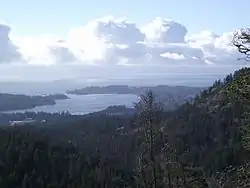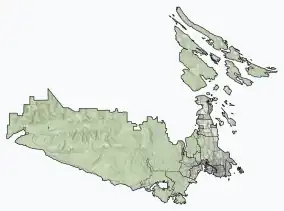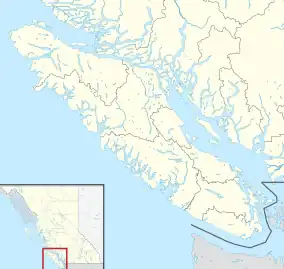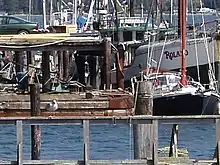Sooke | |
|---|---|
| District of Sooke[1] | |
 | |
 Sooke Sooke (Capital Regional District) Location of Sooke within the Capital Regional District | |
 Sooke Location of Sooke within British Columbia  Sooke Sooke (British Columbia) | |
| Coordinates: 48°22′34″N 123°44′16″W / 48.37611°N 123.73778°W | |
| Country | Canada |
| Province | British Columbia |
| Regional district | Capital |
| Incorporated | December 7, 1999 |
| Government | |
| • Mayor | Maja Tait |
| • Councillors | Jeff Bateman, Al Beddows, Dana Lajeunesse, Megan McMath, Kevin Pearson, Tony St-Pierre. |
| Area | |
| • Total | 56.62 km2 (21.86 sq mi) |
| Elevation | 50 m (160 ft) |
| Population | |
| • Total | 15,086 |
| • Density | 229.6/km2 (595/sq mi) |
| Time zone | UTC−8 (PST) |
| • Summer (DST) | UTC−7 (PDT) |
| Forward sortation area | |
| Highways | 14 |
| Waterways | Strait of Juan de Fuca |
| Website | sooke |
Sooke (/suːk/) is a district municipality on the southern tip of Vancouver Island, Canada, 38 kilometres (24 mi) by road from Victoria, the capital of British Columbia. Sooke, the westernmost of Greater Victoria's Western Communities, is to the north and west of the Sooke Basin. It is a regional centre for residents in neighbouring communities, including Otter Point, Shirley and Jordan River.
Tourism and recreation

Sooke's popularity as a scenic tourist destination has existed for generations. Well-known destinations in Sooke, such as Whiffin Spit Park, the Sooke Potholes Regional Park and adjacent Sooke Potholes Provincial Park, attract visitors both locally and from around the world.
Sooke is also home to the Sooke Region Museum and its Visitor Centre, which offers brochures, flat maps and in-person advice on how best to enjoy the region. The Charters River Salmon Interpretive Centre is on Sooke River Road en route to the Potholes.
The area's popularity has increased as a base for visiting the wilderness parks of Vancouver Island's southwest coast — the West Coast Trail and the Juan de Fuca Provincial Park which includes the now highly popular Juan de Fuca Marine Trail. Sooke, BC is also famous for its beaches just on the outskirts of its neighbouring communities such as Shirley and Jordan River. These beaches include Sandcut, French Beach, Fishboat Bay, China Beach, Mystic Beach and more. Mystic Beach was rated as one of the world's Top-50 beaches in 2022.
Mountain biking is growing in popularity in British Columbia, and Sooke is establishing itself as a destination for the sport. Local advocacy groups such as the Sooke Bike Club are working to have areas such as Broom Hill set aside as parkland.
The Galloping Goose Regional Trail, part of the Trans-Canada Trail, runs through Sooke as far as Leechtown, the former site of a gold-rush town circa 1865. Once a rail line, the Goose is now a popular pedestrian and cycling route connecting Sooke to Victoria.
Arts and culture
The vibrant arts community is represented by the annual Sooke Fine Arts Show (established in 1987). It is renowned as Vancouver Island's premier such exhibition and attracts thousands to Sooke each summer by featuring the adjudicated art of local and regional artists. Sooke is known for its wealth of painters, writers, sculptors, potters, fabric artists, jewellery crafters and more. The Sooke Arts Council plays a large role in fostering art in the region and showcases local artists at its Church Road gallery space.
The Sooke Fall Fair was first held in 1913 and continues on Labour Day weekends annually at the Sooke Community Hall. The latter was built by volunteers in the 1930s and is operated by the Sooke Community Association. The Sooke Music Festival was established in 2016 for annual late-summer weekend gatherings in John Phillips Memorial Park.
Real estate
In April 2022, an average single-family home in Sooke costs $887,500 based on the home price index, drawing from data from the Victoria Real Estate Board (VREB).[3] By June 2022, that number (directly from VREB) increased to $938,000.[4] The average home value as of July 1, 2022 as determined by BC Assessment was $831,000.
Demographics
In the 2021 Census of Population conducted by Statistics Canada, Sooke had a population of 15,086 living in 6,129 of its 6,431 total private dwellings, a change of 16% from its 2016 population of 13,001. With a land area of 56.6 km2 (21.9 sq mi), it had a population density of 266.5/km2 (690.3/sq mi) in 2021.[5] A full summary of Sooke results from the 2021 Census is available from Statistics Canada.
Ethnicity
| Panethnic group |
2021[6] | 2016[7] | 2011[8] | 2006[9] | 2001[10] | |||||||||
|---|---|---|---|---|---|---|---|---|---|---|---|---|---|---|
| Pop. | % | Pop. | % | Pop. | % | Pop. | % | Pop. | % | |||||
| European[lower-alpha 1] | 13,135 | 87.71% | 11,565 | 89.69% | 10,380 | 91.41% | 8,850 | 91.33% | 8,170 | 93.75% | ||||
| Indigenous | 1,065 | 7.11% | 865 | 6.71% | 655 | 5.77% | 390 | 4.02% | 315 | 3.61% | ||||
| East Asian[lower-alpha 2] | 215 | 1.44% | 190 | 1.47% | 75 | 0.66% | 120 | 1.24% | 85 | 0.98% | ||||
| Southeast Asian[lower-alpha 3] | 190 | 1.27% | 100 | 0.78% | 55 | 0.48% | 50 | 0.52% | 50 | 0.57% | ||||
| Latin American | 90 | 0.6% | 20 | 0.16% | 40 | 0.35% | 20 | 0.21% | 40 | 0.46% | ||||
| South Asian | 85 | 0.57% | 65 | 0.5% | 70 | 0.62% | 120 | 1.24% | 15 | 0.17% | ||||
| African | 85 | 0.57% | 35 | 0.27% | 80 | 0.7% | 80 | 0.83% | 30 | 0.34% | ||||
| Middle Eastern[lower-alpha 4] | 25 | 0.17% | 10 | 0.08% | 0 | 0% | 20 | 0.21% | 10 | 0.11% | ||||
| Other/Multiracial[lower-alpha 5] | 75 | 0.5% | 45 | 0.35% | 0 | 0% | 45 | 0.46% | 10 | 0.11% | ||||
| Total responses | 14,975 | 99.26% | 12,895 | 99.18% | 11,355 | 99.3% | 9,690 | 99.86% | 8,715 | 99.77% | ||||
| Total population | 15,086 | 100% | 13,001 | 100% | 11,435 | 100% | 9,704 | 100% | 8,735 | 100% | ||||
| Note: Totals greater than 100% due to multiple origin responses | ||||||||||||||
Religion
According to the 2021 census, religious groups in Sooke included:[6]
- No religion or secular perspectives (9,825 persons)
- Christianity (4,755 persons)
- Judaism (70 persons)
- Buddhism (504 persons)
- Islam (10 persons)
- Muslim (50 persons)
- Indigenous Spirituality (20 persons)
- Hinduism (10 persons)
- Sikhism (10 persons)
Governance
The District of Sooke was incorporated as a municipality on December 7, 1999. It is part of the Capital Regional District.
Municipal
Sooke is governed by a mayor and six councillors, who are elected every four years. The current council was elected on October 15, 2022.[11]
Mayor Maja Tait[12]
Councillor Jeff Bateman
Councillor Al Beddows
Councillor Dana Lajeunesse
Councillor Megan McMath
Councillor Kevin Pearson
Councillor Tony St-Pierre
Provincial
| Year | Liberal | Conservative | New Democratic | Green | |||||
|---|---|---|---|---|---|---|---|---|---|
| 2021 | 17% | 1,256 | 26% | 1,919 | 42% | 3,124 | 7% | 542 | |
| 2019 | 15% | 1,089 | 24% | 1,728 | 37% | 2,691 | 21% | 1,530 | |
| Year | New Democratic | Liberal | Green | ||||
|---|---|---|---|---|---|---|---|
| 2020 | 70% | 3,282 | 13% | 623 | 17% | 789 | |
| 2017 | 54% | 2,745 | 25% | 1,263 | 18% | 931 | |
Sooke in part of the riding of Langford-Juan de Fuca, represented by the BC NDP's Ravi Parmar. He succeeded John Horgan, the former Premier of British Columbia (2017-2022) who first won the seat in 2009 and retired from politics for health reasons in 2023.
Federal
Federally the District is in the riding of Esquimalt-Saanich-Sooke, represented by Randall Garrison of the New Democratic Party. He was first elected in 2011.
Climate
Sooke has a Mediterranean climate, with warm summers and mild winters, defined by the Köppen climate classification as Csb. Although its precipitation is more like dry summer climates, its temperatures resemble oceanic climates as found in Ireland, for example.[15]
| Climate data for Sooke (Park-Isle Marine), elevation: 32 m or 105 ft, 1967-1990 normals and extremes | |||||||||||||
|---|---|---|---|---|---|---|---|---|---|---|---|---|---|
| Month | Jan | Feb | Mar | Apr | May | Jun | Jul | Aug | Sep | Oct | Nov | Dec | Year |
| Record high °C (°F) | 15.1 (59.2) |
15.6 (60.1) |
16.0 (60.8) |
23.6 (74.5) |
28.2 (82.8) |
28.3 (82.9) |
29.4 (84.9) |
29.6 (85.3) |
27.2 (81.0) |
21.5 (70.7) |
21.8 (71.2) |
15.9 (60.6) |
29.6 (85.3) |
| Mean daily maximum °C (°F) | 6.7 (44.1) |
8.4 (47.1) |
10.1 (50.2) |
11.9 (53.4) |
14.2 (57.6) |
16.4 (61.5) |
18.2 (64.8) |
18.6 (65.5) |
17.1 (62.8) |
13.1 (55.6) |
9.3 (48.7) |
6.9 (44.4) |
12.6 (54.6) |
| Daily mean °C (°F) | 4.2 (39.6) |
5.4 (41.7) |
6.6 (43.9) |
8.1 (46.6) |
10.5 (50.9) |
12.6 (54.7) |
14.0 (57.2) |
14.3 (57.7) |
13.0 (55.4) |
9.7 (49.5) |
6.6 (43.9) |
4.5 (40.1) |
9.1 (48.4) |
| Mean daily minimum °C (°F) | 1.6 (34.9) |
2.4 (36.3) |
3.0 (37.4) |
4.3 (39.7) |
6.7 (44.1) |
8.8 (47.8) |
9.9 (49.8) |
10.1 (50.2) |
8.8 (47.8) |
6.2 (43.2) |
3.8 (38.8) |
2.0 (35.6) |
5.6 (42.1) |
| Record low °C (°F) | −10.6 (12.9) |
−12.5 (9.5) |
−6.2 (20.8) |
−2.2 (28.0) |
0.0 (32.0) |
3.3 (37.9) |
5.0 (41.0) |
4.4 (39.9) |
1.7 (35.1) |
−2.8 (27.0) |
−10.8 (12.6) |
−13.9 (7.0) |
−13.9 (7.0) |
| Average precipitation mm (inches) | 193.1 (7.60) |
142.2 (5.60) |
108.8 (4.28) |
75.6 (2.98) |
44.7 (1.76) |
28.6 (1.13) |
21.0 (0.83) |
26.5 (1.04) |
54.8 (2.16) |
121.3 (4.78) |
213.0 (8.39) |
197.2 (7.76) |
1,226.8 (48.31) |
| Average rainfall mm (inches) | 181.5 (7.15) |
138.4 (5.45) |
107.2 (4.22) |
75.2 (2.96) |
44.7 (1.76) |
28.6 (1.13) |
21.0 (0.83) |
26.5 (1.04) |
54.8 (2.16) |
121.3 (4.78) |
209.4 (8.24) |
189.0 (7.44) |
1,197.6 (47.16) |
| Average snowfall cm (inches) | 11.7 (4.6) |
3.9 (1.5) |
1.6 (0.6) |
0.4 (0.2) |
0.0 (0.0) |
0.0 (0.0) |
0.0 (0.0) |
0.0 (0.0) |
0.0 (0.0) |
0.0 (0.0) |
3.4 (1.3) |
8.2 (3.2) |
29.2 (11.4) |
| Average precipitation days (≥ 0.2 mm) | 20 | 17 | 17 | 15 | 12 | 9 | 5 | 6 | 10 | 15 | 21 | 21 | 168 |
| Average rainy days (≥ 0.2 mm) | 18 | 16 | 17 | 15 | 12 | 9 | 5 | 6 | 10 | 15 | 20 | 20 | 163 |
| Average snowy days (≥ 0.2 cm) | 3 | 1 | trace | trace | trace | 0 | 0 | 0 | 0 | 0 | trace | 2 | 6 |
| Average relative humidity (%) | 84 | 83 | 81 | — | — | 82 | 83 | — | — | 87 | 86 | 85 | 83 |
| Source: NOAA[16] | |||||||||||||
Education
Sooke is a part of the School District 62 Sooke. There is one high school, Edward Milne Community School, and one junior high school, Journey Middle School. The four elementary schools in the area are John Muir (in the town's west end), Sooke Elementary (town centre), the French immersion Ecole Poirier (town centre), and Saseenos Elementary (east end). In 2018, SD62 announced it would be building Sooke River Elementary in the Sunriver neighbourhood. Continuing adult education programs are offered by the Edward Milne Community School (EMCS) Society, which also operates with day, evening and weekend programs. The closest post-secondary institutions are Royal Roads University and Camosun College's Interurban campus.
Neighbourhoods
(in order from east to west)
- North Sooke
- Saseenos
- Milne's Landing
- Sunriver Estates
- Sooke Town Centre or "Upsooke"
- Broom Hill
- Whiffin Spit
- Otter Point
- Kemp Lake
Neighbouring communities
- Metchosin - East of Sooke
- East Sooke - South of Sooke
- Otter Point - West of Sooke
Publications
- The long-established weekly newspaper is the Sooke News Mirror, edited by Kevin Laird and one of more than 70 Black Press Media community papers in B.C.
- Meanwhile In Sooke is a Facebook page with more than 26,000 followers as of January, 2023
- Historian Elida Peers' T'Sou-ke: A Festival of Community Spirit (1990), The Sooke Story (1999) and Stories of Sooke (2022) capture the history, heartbeat and people of the Sooke region
Notable residents
- Canadian poet, novelist and playwright Marilyn Bowering lives in the Sooke area.
- Bryce Soderberg, bassist and vocalist for American rock band Lifehouse.
- J. Lee Thompson (1914–2002), British film producer and director (Cape Fear, The Guns of Navarone), died in Sooke.
- Kevin Wenstob, Canadian logger and subject of the reality TV series Big Timber.
- Darrel J. McLeod, Governor General's Award-winning author, lives in the Sooke area.
Notes
- ↑ Statistic includes all persons that did not make up part of a visible minority or an indigenous identity.
- ↑ Statistic includes total responses of "Chinese", "Korean", and "Japanese" under visible minority section on census.
- ↑ Statistic includes total responses of "Filipino" and "Southeast Asian" under visible minority section on census.
- ↑ Statistic includes total responses of "West Asian" and "Arab" under visible minority section on census.
- ↑ Statistic includes total responses of "Visible minority, n.i.e." and "Multiple visible minorities" under visible minority section on census.
References
- ↑ "British Columbia Regional Districts, Municipalities, Corporate Name, Date of Incorporation and Postal Address" (XLS). British Columbia Ministry of Communities, Sport and Cultural Development. Retrieved November 2, 2014.
- 1 2 "Sooke, District municipality [Census subdivision], British Columbia and Capital, Regional district [Census division], British Columbia". Statistics Canada. January 23, 2017. Retrieved February 8, 2017.
- ↑ "Sooke at low end of high home prices". Victoria Real Estate Board. April 14, 2022. Retrieved July 8, 2022.
- ↑ Steibel, Rick (July 4, 2022). "Victoria's hot housing market levels off, supply still important for long-term attainability" (PDF). VREB. Retrieved July 8, 2022.
- ↑ "Population and dwelling counts: Canada, provinces and territories, and census subdivisions (municipalities), British Columbia". Statistics Canada. February 9, 2022. Retrieved February 20, 2022.
- 1 2 Government of Canada, Statistics Canada (October 26, 2022). "Census Profile, 2021 Census of Population". www12.statcan.gc.ca. Retrieved November 9, 2022.
- ↑ Government of Canada, Statistics Canada (October 27, 2021). "Census Profile, 2016 Census". www12.statcan.gc.ca. Retrieved March 5, 2023.
- ↑ Government of Canada, Statistics Canada (November 27, 2015). "NHS Profile". www12.statcan.gc.ca. Retrieved March 5, 2023.
- ↑ Government of Canada, Statistics Canada (August 20, 2019). "2006 Community Profiles". www12.statcan.gc.ca. Retrieved March 5, 2023.
- ↑ Government of Canada, Statistics Canada (July 2, 2019). "2001 Community Profiles". www12.statcan.gc.ca. Retrieved March 5, 2023.
- ↑ "2022 Local Government Election: Official Election Results". Retrieved January 7, 2023.
- ↑ "Mayor Maja Tait". Retrieved July 10, 2021.
- ↑ "Official Voting Results Raw Data (poll by poll results in Sooke)". Elections Canada. Retrieved March 7, 2023.
- ↑ "Official Voting Results by polling station (poll by poll results in Sooke)". Elections BC. Retrieved March 7, 2023.
- ↑ "Sooke, British Columbia Köppen Climate Classification (Weatherbase)". Weatherbase. Retrieved July 10, 2019.
- ↑ "Sooke (01018642) - National Weather Station". NOAA. Retrieved July 10, 2019.
External links
- Official website

 Sooke travel guide from Wikivoyage
Sooke travel guide from Wikivoyage